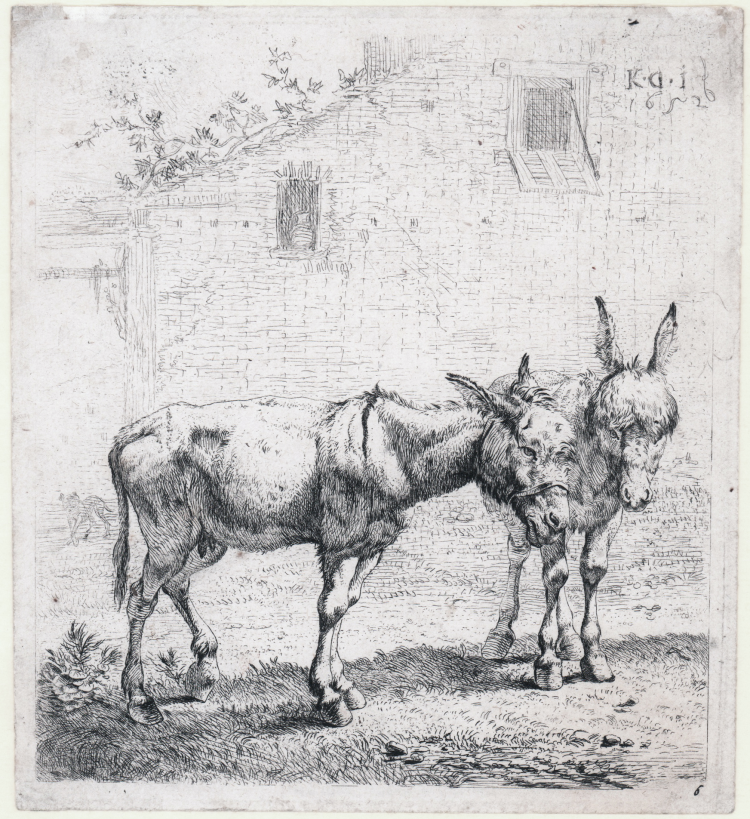




| Reference: | S12582 |
| Author | Karel DUJARDIN |
| Year: | 1652 |
| Measures: | 135 x 150 mm |



| Reference: | S12582 |
| Author | Karel DUJARDIN |
| Year: | 1652 |
| Measures: | 135 x 150 mm |
Etching, 1652, signed on upper plate. Example in the fourth state of four.
Magnificent work, on contemporary laid paper, with small margins, in good condition.
Karel Dujardin was a painter, draftsman and engraver of the Dutch Baroque, born in Amsterdam in 1626 to the painter Dujardin Guillian. His first training was from the artist Nicolaes Berchem who left an important mark on his art. In 1642 he moved to Italy to settle in Rome, where he joined the group of painters of the Bentvueghels, a society of mostly Dutch and Flemish artists active in Rome from about 1620 to 1720. During this period he calls himself "Bokkebaart". After his trip to Italy, from 1652 until 1674, he worked in Amsterdam, France and The Hague. In 1675, invited by his great friend Joan Renst, he returns to Rome. For three years he devoted himself together with his friend to travel the peninsula and then moved to Venice. He paints mythological, allegorical and religious subjects, especially on the life of St. Paul, genre scenes, and excellent portraits. The Dujardin is known above all like "bambocciante", that is like painter of natural thematic and animals, but it is esteemed mostly like landscape painter, genre in which it was inspired at first to the Berchem and then to the Paulus Potter. He was also appreciated as a portraitist of individuals or groups. His activity as an engraver was fervent and traced the themes already undertaken in painting.
Bibliografia
Hollstein 6 IV/IV.
Karel DUJARDIN (Amsterdam, 1626 - Venezia 1678)
|
Karel Dujardin (Amsterdam, September 26, 1622 (or 1626) - Venice, November 20, 1678) was a Dutch painter, draftsman and engraver born in Amsterdam in 1626. Son of the painter Dujardin Guillian, his first training was from the artist Nicolaes Berchem who left an important mark on his art. In 1642 he moved to Italy to settle in Rome, where he joined the group of painters of the Bentvueghels, a society of mostly Dutch and Flemish artists active in Rome from about 1620 to 1720. During this period he calls himself "Bokkebaart". After his trip to Italy, from 1652 until 1674, he works in Amsterdam, France and The Hague. Because of the many debts, he marries a rich lady older than him. In 1675, invited by his great friend Joan Renst, he returns to Rome. For three years he devoted himself together with his friend to turn the peninsula and then move to Venice. He paints mythological, allegorical and religious subjects, especially on the life of St. Paul, genre scenes, and excellent portraits. The Dujardin is known above all like bambocciante, like painter of natural thematic and animals, but it is esteemed mostly like landscape painter, genre in which it was inspired at first to the Berchem and then to the Paulus Potter. He was appreciated also as portraitist of single persons or groups and carried out the activity of engraver. Of a certain thickness his portraits of religious subject, especially those concerning the life of St. Paul. He died in Venice in 1678. Today a good number of his works are exhibited at the Rijksmuseum in Amsterdam and at the National Gallery in London.
|
Karel DUJARDIN (Amsterdam, 1626 - Venezia 1678)
|
Karel Dujardin (Amsterdam, September 26, 1622 (or 1626) - Venice, November 20, 1678) was a Dutch painter, draftsman and engraver born in Amsterdam in 1626. Son of the painter Dujardin Guillian, his first training was from the artist Nicolaes Berchem who left an important mark on his art. In 1642 he moved to Italy to settle in Rome, where he joined the group of painters of the Bentvueghels, a society of mostly Dutch and Flemish artists active in Rome from about 1620 to 1720. During this period he calls himself "Bokkebaart". After his trip to Italy, from 1652 until 1674, he works in Amsterdam, France and The Hague. Because of the many debts, he marries a rich lady older than him. In 1675, invited by his great friend Joan Renst, he returns to Rome. For three years he devoted himself together with his friend to turn the peninsula and then move to Venice. He paints mythological, allegorical and religious subjects, especially on the life of St. Paul, genre scenes, and excellent portraits. The Dujardin is known above all like bambocciante, like painter of natural thematic and animals, but it is esteemed mostly like landscape painter, genre in which it was inspired at first to the Berchem and then to the Paulus Potter. He was appreciated also as portraitist of single persons or groups and carried out the activity of engraver. Of a certain thickness his portraits of religious subject, especially those concerning the life of St. Paul. He died in Venice in 1678. Today a good number of his works are exhibited at the Rijksmuseum in Amsterdam and at the National Gallery in London.
|